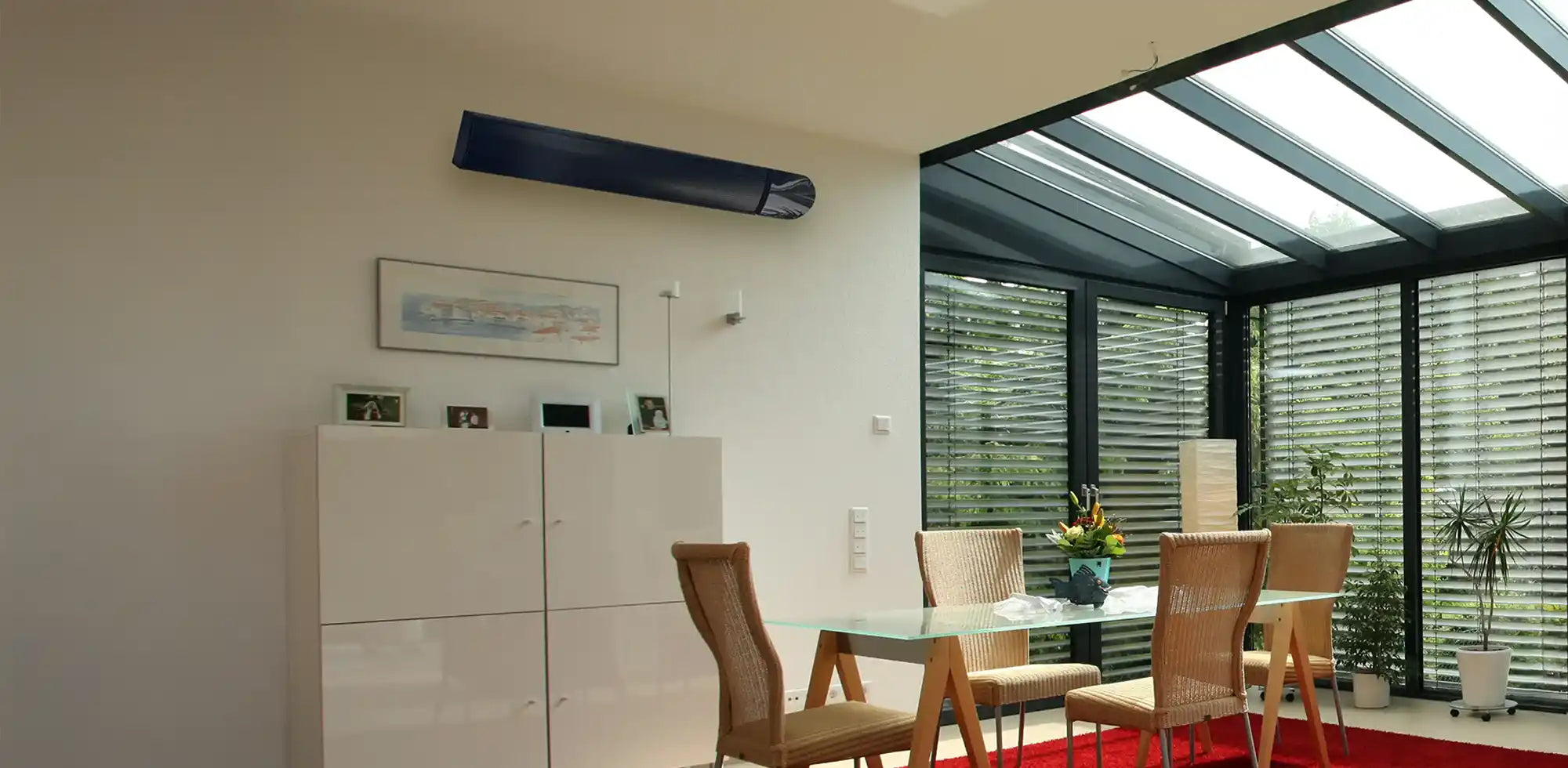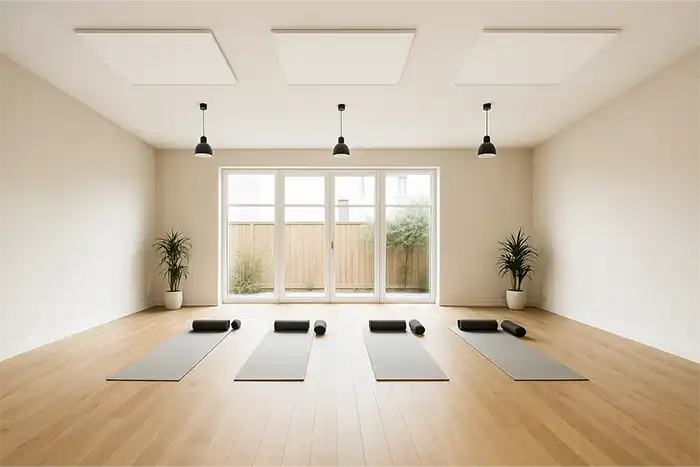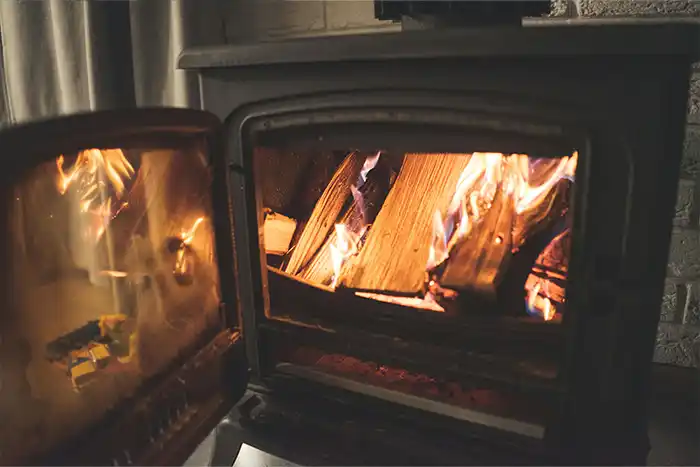Have questions about the warmth and efficiency of infrared heating? You've come to the right place! This FAQ section is designed to answer all your burning inquiries (pun intended) about infrared heaters.
Explore the questions below to discover how infrared heating can transform your space, from understanding how they work to maximizing their energy-saving potential. Still curious? Don't hesitate to reach out to our friendly customer support team – we're always happy to help!
Yes, it’s very safe. Infrared panels don’t burn fuel or blow hot air, and they don’t get dangerously hot to the touch (especially ceiling-mounted models). Plus, there are no moving parts, open flames, or emissions — making them ideal for allergy sufferers and family homes. Find out more here
Infrared (radiant) heaters work differently from traditional convection heaters.Radiant heat warms objects, surfaces, and people directly, rather than heating the air first. Because of this, the room can feel warm and comfortable even when the air temperature is still rising slowly.A thermostat measures only the air temperature, not the radiant warmth. This means:The heaters may already be producing strong heat that you can feel on your skin or on surfaces.But the air in the room takes longer to heat, so the thermostat reading increases gradually.This is completely normal for infrared systems and does not indicate a fault.As the objects and surfaces in the room warm up, they slowly release heat back into the space, and the air temperature eventually rises to match the thermostat setting.So the comfort level is felt much sooner, even though the thermostat takes more time to reach the target temperature.
Infrared heating uses radiant heat to warm objects and people directly — just like the sun. Instead of heating the air, it gently warms surfaces in the room, which then release that warmth back into the space. The result? A faster, more comfortable heat with no cold drafts.
Yes — many homes now use infrared as their main heating solution. It’s perfect for open-plan spaces, apartments, and new builds. As long as the panels are correctly sized for each room, there’s no need for traditional radiators or gas boilers.
Extremely. Infrared panels convert up to 98% of electricity into usable heat, with minimal heat loss. And because they heat people and objects, not the air, you get the warmth you need using less energy — especially when combined with smart thermostats or zoning.
Running costs depend on usage and electricity rates, but they’re generally lower than traditional heating. Zoning and smart scheduling help you heat only the rooms you’re using, and low-wattage panels keep your energy bills in check.
You’ll feel the warmth within minutes. Unlike central heating, there’s no waiting for air to heat — the panels start warming objects and people almost instantly.
We advise our customers to mount your infrared heaters anywhere above eye level or flush mounted on the ceiling. Having your infrared heaters high up on the wall will allow an unhindered spread of heat.
Having you heaters pointed down towards the floor will make sure your comfortably heated at all times and will help the heat distribute more effectively across the room. If you install your infrared heaters mounted low on the walls, similar to radiators will prevent the heat to evenly spread effectively, and will only heat the air, rather than directly heating individuals. You can purchase our suspension mounting kits for Infrared panels and heating bars.
You can connect your heater to an external thermostat or timer. Although, external controls are only compatible with heaters that do not have built in timers or thermostats. It is important to consider if you would like a manual wall mounted thermostat, or a complete wireless option that can be controlled with an app. Find our thermostats here.
Absolutely! You can group classic infrared panels and heater bars together to make things super energy-efficient, easy to control and evenly warm. Plus, it also can be a budget-friendly setup and solution.
Both work great. Ceiling-mounted panels offer the best coverage and are ideal for keeping walls free. Wall-mounted panels work well above seating or in home offices where targeted heat is useful.
Most of the KIASA infrared heaters are DIY-friendly, especially plug-in models. For hardwiring or ceiling installations, a qualified electrician is recommended — but no major plumbing or structural work is needed. Installation is typically quick and hassle-free.
Yes. Most infrared heaters work with popular systems. Many models also have dedicated apps that let you schedule heating, control zones, and monitor usage straight from your phone.
Yes — just make sure to choose IP-rated panels for moisture-prone areas. Ceiling-mounted infrared panels are a great option for bathrooms, keeping your floor space clear and helping reduce humidity.
Absolutely. Infrared heating is a perfect partner for solar or wind energy systems. Because it runs on electricity and uses low wattage, it’s well-suited for sustainable, off-grid, or net-zero homes.
It’s 100% electric, with zero emissions at the point of use. There’s no gas, no oil, and no waste heat. Combine it with renewable energy sources, and you’ve got a future-proof, sustainable heating solution that’s kind to the planet and your pocket.
Infrared heaters can be used as primary source of heating or a secondary source to add a little extra boost.
For a full house system, its all about finding the correct size and wattage requirement for that room. If you are ever unsure, you can always get in touch here.
• Infrared heating panels typically come with several safety features to protect users and their property. These features may include:
• Overheat protection: This feature prevents the panel from getting too hot and potentially causing a fire.
• IP-rated waterproof: Some panels are designed to be waterproof, which makes them suitable for use in bathrooms and other damp areas.
• Automatic shut off: This feature can turn off the panel if it overheats, or if it is accidentally knocked over.
• Wall mounted: This feature keeps the panel away from reach and reduces the risk of accidental contact.
The ideal IP Rating (Ingress Protection Rating) is IP65. All panels have a rating of 65. This means that it has full protection against from total dust ingress and it’s protected from low pressure water jets from any direction.
FAQ
Yes, Infrared heaters can be used as personal heaters regardless of the size/dimensions of the panel.
There are many factors such as size and insulation to consider when deciding how many watts you need or even how many Infrared Panels you need. For any larger rooms we recommend more than one Panel so it can distribute heat evenly and quicker. Smaller rooms, depending on the size, one should be sufficient enough. Infrared Heating works by heating up the thermal mass of the interior, so after starting it initially; it can take anything from a couple of hours to a few days to feel its full effect so, if it’s a room that’s damp, it will take longer. However, if you are unsure of what you need you can always get in touch with us via chat on or website or even call us directly for free advice on 0116 488 5150.
Short answer is no. The panels have been designed to be the exact opposite. Keeping in mind that each interior is different, they have been manufactured with a smooth finish that blends in with all types of décor.
At Kiasa, we have two different types of infrared panels. Classic and Smart - The classic comes as a simple on/off panel which can be controlled using external timers or thermostats. The smart panels come with built in thermostat, Wi-Fi app control and a remote control as well.
We would advise against painting on your panels.
There is little to no maintenance and no service cost. We would advise you to only use a damp cloth when you’re cleaning or dusting. There also no servicing costs..... you’re welcome!
No. There is no light emitted from the panel.
The length of cord is approx 1.5meter, however it can be extended easily by qualified electrician.
KIASA offers 3 years of all inclusive warranty with every Infrared Panel Heater. Standard 15 months warranty is active from the day of purchase.
For further peace of mind, KIASA offers additional warranty FREE OF CHARGE! Simply complete the registration form on manufacture's website and keep your receipt as proof of purchase.
Classic+ Remote Control
When pairing the remote to your Classic+ Infrared Panel, all you have to do is switch on the panel, hold down the + and – button down together until the ‘connect’ button has started to flash and you hear a ‘beep’ sound indicating that it is connected.
When the ‘connect’ sign on the remote has stopped flashing, this is your second indicator that a connection has been established. You are now ready to set up any mode you like.
After successfully pairing the remote to your panel, you can set up to 4 different modes using the remote.
Pressing down the M button you will be able to switch between the system time and the thermostat. When you have decided, press down and hold the M button.
When in thermostat mode the mode use the + and – buttons to decide if its mode 1, 2, 3 or 4 (the programme slots) you want to change. When you’re ready press ok.
The ‘target’ temperature should immediately start flashing. Using + or – set the desired temperature and then press ok.
Next it will ask you to set the days of the week using the + and - buttons. You have 4 options. You can set it on weekly, weekend only, daily or just for the just for weekdays. When you have decided press OK.
Next it will give you the option to set the ‘ST’ (start time) first and then, after you have pressed ok, the option for the ‘ET’ (end time) will come up. Press ok and you are good to go.
NOTE: When the screen has been left on idle for more than a few seconds, the screen will switch off to save power.
When you have set up your mode, you will know that it’s on when the ‘on’ button is on and the sign for the ‘heat’ mode is on.
Patio Heaters
They can be replaced by a professional electrician.
The halogen bulbs have a long life of approximately 4000 hours and be replaced at low costs with little to no hassle.
It is important to make sure that there aren’t any flammable materials near the halogen heaters as it could create a fire hazard.
Halogen heaters are completely safe to run, they don't release any harmful gases such as carbon monoxide or smoke.
Halogen heaters provides instant heat, and the infrared heat that is released, can effectively heat any outdoor space. The costs of running a halogen heater using 1000 watts would be approximately 18 pence per hour.
Kiasa Smart Heater Bars
We advise installing the heater at least 1.8m from the floor and tilt to the appropriate direction to maximize the efficiency of the heater.
The DW range has TWO settings. Give you the option to use it at half the wattage. The J Range doesn't have this setting. It has one setting.
The cable is approx. 1.7m. Yes the cable can be extended however, we do recommend that you use a qualified electrician to install your heater.
Yes. The wall fixings will be included as well at the brackets needed to mount the products. Remote control will also be included, but only with the DW Range. The J Range is not compatible with a remote.
No, there is no light emitted from the product. The only light that will be on is the LED screen on the DW range or the little red right on the J Range. When the heater is initially started, there will be a smell coming of the heater for a few hours. This is perfectly normal as this is burning off the protective oils from the heater.
You can use an external thermostat but only with the J Range. As this doesn't have a built in thermostat it will be compatible with any external thermostat. The DW Range will NOT work an external thermostat.
The DW range comes with WIFI compatibility. You can do the all the same things as you do from the remote control, from the App as well.
Classic Heater Bars
You must first calculate the volume of your room. You can figure this out by multiplying the room’s length by its width and then multiplying the result by the height. Your outcome will be in m3, assuming that your initial measurements were made in metres. Based on the national average, you would need to times the m3 with anywhere between 70w per m3 or 110 per m3. Depending on how well-insulated your home is.
Yes, you can leave the infrared heater bar on all the time. However, we do not advise this and recommend only keeping your heater bar ON when the space is being occupied to avoid energy waste. Where heater bars are concerned you can use external timers for our classic J range that comes without controls and a thermostat but our smart range comes in with all the built-in features including app controls. This means you can preheat a room before you go in from your phone.
Infrared heater bars do not heat the air, as they simply warm humans, pets, areas and objects due to their use of radiant heat. Infrared heater bars are capable of heating any space as it heats the fabric of the building as well. However, Infrared works best when it is used in a room filled with objects, so the heat that is being absorbed is reflected back into the room.
When using infrared heaters, we advise that you follow the same rules as you would with any other heater and do not leave it unattended for long periods of time to avoid any accidents. Keep any flammable objects and liquids or any combustible materials away from the heater itself. Regardless, all of our heaters have built-in safety. Once it reaches a certain temperature, it will automatically switch off.
No, an infrared heater bar cannot be utilised to dry clothes, this is a potential fire hazard. We strictly advise using an infrared heater bar to keep your space heated. Keeping anything in front of the heater will prevent the heater from working effectively.
We do not recommend using our infrared heater bars outside as they only have an IP 44 rating, meaning it is only protected from low-velocity water splashes and not heavy rain. We do provide outdoor patio heaters with an IP rating of 65. Outdoor infrared heaters are effective because they do not spend energy heating air that can be lost by draughts, opening doors, or the natural circulation of air, they are ideal for outdoor or extremely draughty spaces.




